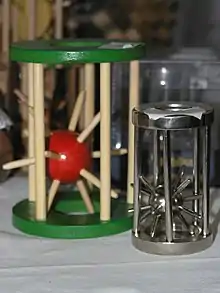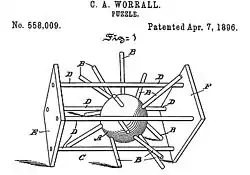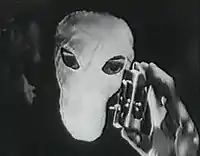Hedgehog in the Cage
Hedgehog in the Cage (in Czech: Ježek v kleci) is a mechanical puzzle popular in the Czech Republic which features prominently in the "Dobrodružství v temných uličkách" (Adventures in the Dark Alleys) trilogy of adventure stories by Jaroslav Foglar. The puzzle consists of a small sphere with protruding spikes of various lengths contained within a cylinder perforated with holes of different sizes. The challenge posed by the puzzle is how to release the sphere (the hedgehog) from the cylinder (the cage).

History

Although known mainly through the children's stories written by the Czech Jaroslav Foglar in the 1940s, Hedgehog in the Cage has its origins in the United States. The first known similar puzzles were made since 1886 by Trilby company in Brooklyn.[1] The puzzle was patented by the American inventor Clarence A. Worrall in Philadelphia, Pennsylvania, on 7 April, 1896.[2][3] It has been suggested that Worrall's invention was inspired by a Japanese puzzle called the Snake and Star, which appeared in the catalogue of the games manufacturer Selchow & Righter on 25 May, 1895.[2] The principle of both inventions is similar: solving the puzzle involves finding the correct position and angle that allows the object ("the hedgehog" or "the star") to be removed from its entrapment in the cage or the snake.
It is not known exactly how Jaroslav Foglar knew the puzzle, but he probably encountered a copy of the puzzle by Trilby company, a few pieces could be found on the territory of the First Czechoslovak Republic.[4] The Hedgehog puzzle was produced in Czechoslovakia since 1941 at a toy factory in Roudnice nad Labem.[5][6]
Mystery of the Conundrum

It was not until 1940 that it achieved its remarkable level of popularity, when Jaroslav Foglar published Záhada hlavolamu (Mystery of the Conundrum), the first part of his sequence of stories about the Rychlé šípy ("Rapid Arrows"[7]) boys' club.[note 1] Rychlé šípy comics series began to appear in the magazine Mladý hlasatel (Young Herald) in December 1938, and gradually became the most popular series in the history of the Czech comics.[8] However, their adventures involving the Hedgehog in the Cage are written in the standard novel form.
The Hedgehog in the Cage plays a key role in the story and its sequels in the trilogy, Stínadla se bouří (The Shades are Revolting) and Tajemství velkého Vonta (Secret of the Supreme Vont). The novel tells the story of a young apprentice locksmith Jan Tleskač, who invents a flying bicycle. Tleskač also owns a copy of the puzzle, which he refers to as the "Hedgehog in the Cage". He succeeds in removing the hedgehog from its cage, splits the sphere in two parts and hides the plans of his invention inside it before reuniting the two hemispheres and replacing the Hedgehog inside its Cage. After Tleskač's mysterious death, local children take the Hedgehog as a symbol of leadership for their secret society.[9]
Cultural references
From the 1940s onwards, the puzzle was manufactured in Czechoslovakia in a variety of forms and sizes. It became particularly popular in 1969 when Czechoslovak Television broadcast a TV series based on the novel.[10]
The Removing the Hedgehog from the Cage World Championship has been held annually in the Czech Republic since 2000.[11]
In 2010, an exhibition was held in the Galerie jedné věci gallery in Prague to commemorate the 70th anniversary of the novel's publication. 70 variants of the puzzle were displayed in the exhibition. Among them was a golden Hedgehog in the Cage and Tleskač's bicycle.[12][13][14][15]
Notes
- The first edition of the novel was published in sequels in a popular magazine Mladý hlasatel (Young Herald) from 1940.
References
| Wikimedia Commons has media related to Hedgehog in Cage. |
- "Historie - Hlavolam Ježek v kleci - Informace a obchod". www.jezcivkleci.cz.
- "Americko-japonský hlavolam je českým fenoménem" (in Czech). novinky.cz. 2011-04-07. Retrieved 28 September 2011.
- "Patent number: 558009". Google Patents. Retrieved 28 September 2011.
- "Nález z pole poodhaluje záhadu hlavolamu! - články - Hlavolam Ježek v kleci - Informace a obchod". Jezcivkleci.cz.
- "Ježek v kleci" (in Czech). Hospodářské noviny. 4 June 2010. Retrieved 8 October 2011.
- "Články o nás - Hlavolam Ježek v kleci". Jezcivkleci.cz. Retrieved 13 December 2020.
- Štenclová, Berta (5 January 2009). "Immortal Rychlé šípy (Rapid Arrows)". Portal of Prague. Archived from the original on 25 May 2011. Retrieved 8 October 2011.
- Leschtina, Jiří (17 December 2008). "Rychlé šípy stále žijí. Legenda ze dvou stran" (in Czech). Hospodářské noviny. Retrieved 10 October 2011. ("...psát o autorech a okolnostech vzniku nejslavnějšího českého komiksu je nošením dříví do lesa...")
- based on the plot of the book: Foglar, Jaroslav (2003). Záhada hlavolamu. Prague: Olympia. ISBN 80-7033-779-6.
- "Záhada hlavolamu (TV seriál)" (in Slovak). CSFD.cz. Retrieved 8 October 2011.
- "V Praze se koná mistrovství světa ve vyjímání ježka v kleci" (in Czech). Czech Radio. 28 November 2009. Retrieved 8 October 2011.
- "Záhadu hlavolamu připomíná po 70 letech 70 ježků v kleci" (in Czech). Czech Television. 1 September 2010. Retrieved 8 October 2011.
- ""Nebýt to Rychlé šípy, asi bych to nedělal," říká Marko Čermák" (in Czech). Czech Television. 19 September 2010. Retrieved 8 October 2011.
- "Výstava Rychlých šípů: Sedmdesát ježků v kleci a Tleskačovo létající kolo" (in Czech). Hospodářské noviny. 2 September 2010. Retrieved 8 October 2011.
- Zatorsky, Jan (30 August 2010). "Legendární Rychlé šípy si přinesou sedmdesát ježků v kleci" (in Czech). Týden. Retrieved 8 October 2011.
External links
- ježcivkleci.cz - fan website about the puzzle
- https://web.archive.org/web/20140312212430/http://www.hlavolamy.info/hlavolamy/jezek-v-kleci/
- Ježek v kleci, an audio story available at the website of Radio Wave (Czech Radio)